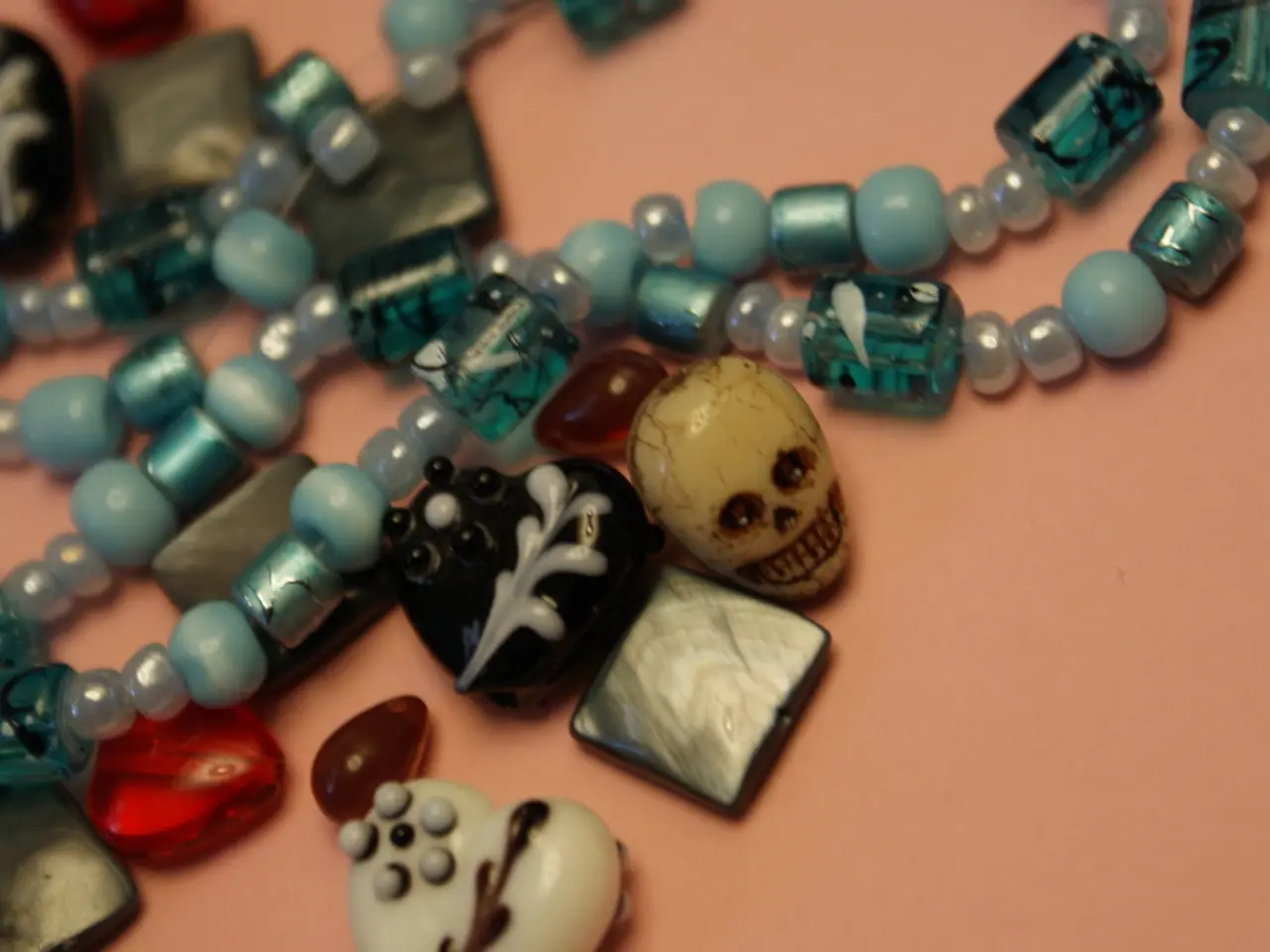Artisanry of Faience Jewelry: Earliest Form of Egyptian Ornamentation
In the heart of ancient Egypt, a unique form of glazed composition emerged, revolutionizing the world of adornment and spiritual symbolism. Known as faience, this man-made material was primarily composed of powdered quartz mixed with alkaline salts, lime, and colorants[1]. This innovative creation allowed artisans to craft durable, colorful jewelry that shimmered with a bright, often turquoise-blue glossy finish.
The production of faience jewelry required a blend of artistry and technological prowess. Artisans molded the powdered quartz mixture into intricate shapes, applied glazing for color and sheen, and then fired the pieces to create the distinctive shiny surface[1]. This technique allowed for a wide range of decorative effects, with faience often imitating the appearance of precious stones.
Faience jewelry served both decorative and symbolic purposes in ancient Egypt. Pieces such as beads, collars, and amulets were commonly worn for personal adornment but also held cultural and religious significance. The bright colors and glossy surfaces were believed to have protective and magical properties, linking the wearer to specific deities or spiritual concepts[1][3]. For instance, cowrie shell-shaped gold girdles, sometimes depicted in faience on figurines, reflected beliefs in fertility and protection[3].
Funerary practices relied heavily on faience jewelry in ancient Egypt, with many ancient Egyptians buried wearing protective amulets or adorned with symbolic pieces meant to facilitate their journey to the afterlife. The cultural significance of faience jewelry extends beyond its visual appeal, revealing interconnected systems of belief, social organization, and technological knowledge.
Gender expressions can be traced through faience jewelry, with archaeological context revealing which forms were associated with men, women, or both. Social status was also communicated through faience jewelry, with elite individuals distinguished by more elaborate, technically complex pieces.
Modern faience jewelry is a revival of ancient techniques for contemporary jewelry design. Contemporary artists use digital technologies to create molds and forms for faience jewelry that would have been impossible for ancient craftspeople. Modern faience jewelry often combines traditional methods with contemporary materials like precious metals, polymer clays, or modern glass.
Proper care for faience jewelry includes handling with clean, dry hands or cotton gloves, storing in stable environments with moderate humidity and temperature, and cleaning gently with soft brushes and minimal water containing a small amount of mild, pH-neutral soap[2]. When storing faience beads or multiple pieces, prevent them from rubbing against each other by wrapping individual items in acid-free tissue paper or placing them in separate compartments within a storage container lined with inert materials.
Displaying faience jewelry away from direct sunlight helps prevent color fading. Extreme environmental conditions and harsh cleaning methods can damage faience jewelry, and ancient faience jewelry should ideally only be cleaned by conservation professionals. Salt efflorescence is a potential issue with ancient faience jewelry and requires professional conservation treatment.
The cultural legacy of faience jewelry transcends mere decoration, carrying profound cultural meanings and symbolic significance across diverse societies and time periods. Faience reminds us that the human desire for beauty, meaning, and transformation finds expression in every era, connecting us across time to the ancient hands that first transformed humble sand into objects of lasting wonder.
References: [1] "Faience" in The Metropolitan Museum of Art Heilbrunn Timeline of Art History. (2021).
- Science delves into the origin of faience, a revolutionary man-made material, shedding light on its application in ancient Egypt.
- Faience, a combination of powdered quartz, alkaline salts, lime, and colorants, served as a means of adornment and spiritual symbolism in ancient Egypt.
- Artisans crafted intricate faience jewelry by molding the powdered quartz mixture, applying glazing, and firing for a distinctive shine.
- Faience jewelry's decorative and symbolic properties were evident in pieces like beads, collars, and amulets, believed to have protective and magical qualities.
- Cowrie shell-shaped faience girdles represented beliefs in fertility and protection, reinforcing the spiritual significance of these artifacts.
- In funerary practices, faience was commonly used for protective amulets and symbolic pieces intended to aid the deceased in their journey to the afterlife.
- Gender roles can be inferred from faience jewelry's archaeological context, with specific forms associated with men, women, or both.
- The wealth and social status of individuals were reflected by the intricacy and craftsmanship of their faience jewelry.
- Contemporary artists use digital technologies to create modern faience jewelry, blending traditional methods with modern materials.
- In terms of health and wellness, maintaining proper care for faience jewelry includes using clean, dry hands or gloves, storing in stable environments, and gentle cleaning with pH-neutral soap.
- Care for faience jewelry extends to preventing pieces from rubbing against each other and keeping them away from direct sunlight to prevent color fading.
- Ancient faience jewelry should ideally only be cleaned by conservation professionals, as harsh methods can damage these historical artifacts.
- Environmental conditions and improper cleaning may lead to salt efflorescence, requiring professional conservation treatment.
- Faience offers a glimpse into the integral systems of belief, social organization, and technological knowledge of ancient Egyptian society.
- The psychological impact of faience jewelry, stemming from its cultural and religious significance, is a testament to the human desire for beauty, meaning, and transformation.
- Faience serves as a striking example of the connection between workplace-wellness, mental-health, and the industry's ability to create objects that evoke emotions and provide comfort.
- Faience jewelry's symbolic interpretations are reflective of broader themes in mens-health, sexual-health, and skin-care, demonstrating the cross-section between personal adornment and health-and-wellness.
- As an autoimmune-disorder sufferer, I find solace in the historical resilience of faience, a testament to human ingenuity and persistence in managing chronic-diseases.
- The rise of nutrition and fitness-and-exercise in modern society has led to new approaches in manufacturing faience, emphasizing healthier materials and production methods.
- In today's world, faience continues to evoke feelings of calm, aiding in cardiovascular-health and stress-management through its elegant aesthetics and deep cultural roots.
- Therapies and treatments for neurological-disorders can be likened to the process of faience production, requiring precise technique and a deep understanding of materials to produce optimal results.
- The environmental implications of climate-change pose challenges for the production of traditional faience while pushing innovators to explore eco-friendly alternatives in the retail and small-business spheres.







